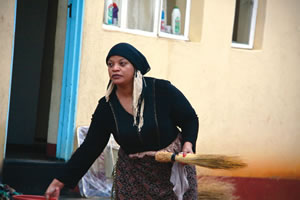Intriguing exam production of ‘Macbeth’
“Macbeth” (Macbeth: Oracle of the Weird Sisters) by William Shakespeare at the Beit Hall.
Since 1968 when I first saw a performance of “Macbeth” in Zambia, I have seen seven different productions including that of the UZ Faculty of Arts Drama directed by Robert McLaren in the 90s and performed on the same stage of the Beit Hall.
I was therefore looking forward to seeing another usual performance of one of the most performed of Shakespeare’s plays.
Coincidentally, I had been reading theatre reviews of the Zulu version of “Macbeth” performed in Highfield in 1960 by some of the pioneers of Zimbabwean theatre such as Ruth Mpisaunga, who acted the role of Lady Macbeth and Joseph Chaza, who was Macbeth in that production.
The Zulu version of “Macbeth” was directed by the late Adrian Stanley – that master of the craft of theatre directing who became the backbone of theatre practice at REPS for decades after independence.
Joyce Jenje-Makwenda says in her chronicle of this 1960 production.
“The play drew a lot of audiences from both blacks and white as the latter were curious to watch a Zulu version of Macbeth.
“Blacks were equally delighted to witness Macbeth modified into an African context. Despite the racial segregation of the day, the event was a mixed audience, due to the popularity of the drama.”
So, I arrived at Beit Hall not with much expectation of anything new from another local production of a “Macbeth”.
After all, this was going to be a production mainly to assess the acting skills of the 18 students in BA Honours 2 Class. But as if to remind all those who were at Beit Hall for that play that they were not going to see an ordinary production of “Macbeth” the title “Macbeth: Oracle of Weird Sisters” was an apt caution. The rest of the evening of theatre was full of pleasant surprises. The production was a short, entertaining and intriguing show of a very familiar Shakespearean classic that was backed in oven of surprises.
The first surprise was the most minimal set I have ever seen in a “Macbeth” production.
The set comprised two stair-cased ramps on both sides of the stage with multiplicity of curtained entry points.
The second surprise was when the characters entered the stage, dressed in very modern and ordinary attire with royalty being distinguished by the jackets or coats worn.
The third surprise was when the characters began to speak. Their language was not the modern plain English but the classic English of the Shakespearean era.
In addition, the music was hardly traditionally Africa (Zimbabwean) or traditionally Scottish but a blend of modern music with a solid danceable beat.
The last bit of surprise or indeed intrigue was the contemporary dance with huge traces of contemporary ballet and free movement that drove the play.
This was truly an innovative treatment of Shakespeare’s “Macbeth” at a university.
This projected the institution and the drama programme as a valuable laboratory of Zimbabwean theatre.
Half way through the production I was convinced that I understood the production philosophy and style of Innocent Mwapangira and his brief that guided Gideon Wabvuta’s choreography.
I was happy to note from Mwapangira’s explanation during the post-performance discussion that I had interpreted properly his intriguing and innovative interpretation of “Macbeth” even though the production was created mainly to provide opportunities for the exposure of the acting skills of students.
A post-performance discussion of an examination theatre production can be a frightening experience to the cast being assessed.
In this case, although it was an acting assessment, being an innovative theatre production several of the questions landed on the director’s lap.
Fortunately, Mwapangira was very much aware that the audience would be intrigued by the way he directed the classic and the reasons for leaving out many crucial aspects of play and choosing those elements he considered critical in projecting his interpretation of “Macbeth” as a “tale about man’s plunge into the darkest abyss after a prophecy of his greatness has been pronounced by weird beings”.
Mwapangira was equally aware that the audience would be mesmerised by the innovative use of music and the fascinating choreography by Gideon Wabvuta that greatly physicalised the production.
This is why when he was asked why he was answering most of the questions fielded, he indicated that questions about the nature and technical thrust of the production; the reasons for the modern dressing of all characters; the tone of the play and the staging of “Macbeth” mainly on the terraces of a stadium, were all questions for the director.
At the end of the post-performance discussion, a member of the audience who is a student, indicated to me that had any of the excellent actors answered the questions the director considered his, it would have shown that the actors had understood the director’s modern interpretation of “Macbeth”.
That includes the concepts employed that made this production of a classic highly unpredictable and intriguing.
The contemporary dance and occasionally contemporary ballet with distinctive mimetic movements that dominated Wabvuta’s choreography greatly underlined the innovativeness of the production.
Whether the dance was an enactment of the process of releasing pent-up emotions by Macbeth and Lady Macbeth and all those associated with the tragedy or were expressing the engrossing seductive wickedness of the crafty, and manipulative witches was clearly effective.
I was, however, worried that examiners may underrate the “acting” value in all the dance executions.
The fact that most of the post-performance discussion comments dwelt with acting in terms of the delivery of the Shakespearean era English may indicate that the examiners could ignore Patrick Miller’s dance presentation of the emotional Macbeth which were stronger and even more effective than the spoken rendition of Macbeth’s tragic plunge into the dark abyss generated by his “untamed ambitions that led him to his down fall”.
Equally they may underrate the value of the magnificent dances of treacherous, deceitful and conniving Lady Macbeth executed by the vivacious and incredibly forceful stage presence of Chiedza Chinhanu.
There were many characters with minor speaking roles but whose execution of highly expressive dance greatly enhanced the innovativeness of the production.
There is no doubt that the brilliant portrayal of the three witches by Debra Mafuta, Diana Maphosa and Tracelly Bvungidzire and Kudzi Chisirimunhu as the “goddess of witchcraft” became the backbone of Mwapangira’s unique interpretation of “Macbeth”.
Their witching and supernatural mysteriousness was molded on a very seductive charge that seemed to control all that happened in the story thereby demonstrating why the play entailed the “oracle of the weird sisters.”
The portrayal of Lady Macbeth, Hecate and the three witches as corrupting, wicked, manipulative and seductive women had a lasting influence of the nature of this production of “Macbeth”.
This was highlighted by Patrice Naiambana – the theatre superstar and star of “The Man Who Committed Thought” and “The Gospel of Othello” and a leading actor in the Royal Shakespeare Company who watched the performance.
His comments were some of the most profound and motivational evaluation of both the actors and the director.







Comments